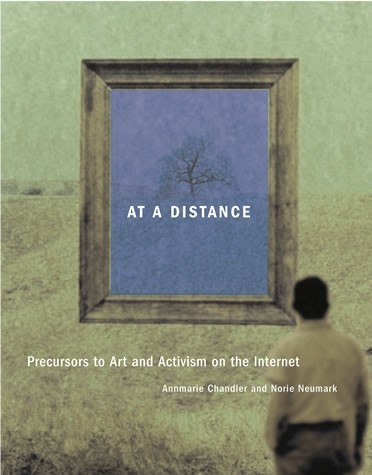Annmarie Chandler, Norie Neumark (eds.): At a Distance: Precursors to Art and Activism on the Internet (2005)
Filed under book | Tags: · 1970s, 1980s, activism, art history, experimental art, fluxus, mail art, media art, network art, network culture, networks, new media, radio art, telematics

“Networked collaborations of artists did not begin on the Internet. In this multidisciplinary look at the practice of art that takes place across a distance—geographical, temporal, or emotional—theorists and practitioners examine the ways that art, activism, and media fundamentally reconfigured each other in experimental networked projects of the 1970s and 1980s. By providing a context for this work—showing that it was shaped by varying mixes of social relations, cultural strategies, and political and aesthetic concerns—At a Distance effectively refutes the widely accepted idea that networked art is technologically determined. Doing so, it provides the historical grounding needed for a more complete understanding of today’s practices of Internet art and activism and suggests the possibilities inherent in networked practice.
At a Distance traces the history and theory of such experimental art projects as Mail Art, sound and radio art, telematic art, assemblings, and Fluxus. Although the projects differed, a conceptual questioning of the “art object,” combined with a political undermining of dominant art institutional practices, animated most distance art. After a section that sets this work in historical and critical perspective, the book presents artists and others involved in this art ‘re-viewing’ their work—including experiments in ‘mini-FM’, telerobotics, networked psychoanalysis, and interactive book construction. Finally, the book recasts the history of networks from the perspectives of politics, aesthetics, economics, and cross-cultural analysis.”
Publisher MIT Press, 2005
ISBN 0262033283, 9780262033282
xiv+486 pages
Reviews: Publishers Weekly (2005), Vincent Bonin (2005), Graham Meikle (Scan, 2006), Paolo Gerbaudo (Culture Machine, 2006), Joel Slayton (Art Book, 2006), Karrie Karahalios (New Media & Society, 2006), Jennifer Way (RCCS, 2008, with responses from editors).
PDF (updated on 2019-11-22)
Comments (3)Wendy Hui Kyong Chun, Thomas Keenan: New Media, Old Media: A History and Theory Reader (2006)
Filed under book | Tags: · media history, new media, reader, theory

The term “new media” rose to prominence in the 1990s, superseding “multi-media” in business, art, and culture. The phrase obstinately portrays other media as old or dead. But what, if anything, is truly unique or revolutionary about new media?
New Media, Old Media is a comprehensive anthology of original and classic essays that explore the tensions of old and new in digital culture. Leading international media scholars and cultural theorists interrogate new media like the Internet, digital video, and MP3s against the backdrop of earlier media such as television, film, photography, and print. The essays provide new benchmarks for evaluating all those claims–political, social, ethical–made about the digital age. Committed to historical research and to theoretical innovation, they suggest that in the light of digital programmability, seemingly forgotten moments in the history of the media we glibly call old can be rediscovered and transformed. The many topics explored in provocative volume include websites, webcams, the rise and fall of dotcom mania, Internet journalism, the open source movement, and computer viruses.
New Media, Old Media is a foundational text for general readers, students, and scholars of new media across the disciplines. It is essential reading for anyone interested in understanding the cultural impact of new media.
Published by Routledge, 2006
ISBN 0415942241, 9780415942249
418 pages
PDF (updated on 2012-7-18)
Comments (3)Matthew Fuller: Media Ecologies: Materialist Energies in Art and Technoculture (2005)
Filed under book | Tags: · art, cctv, hylomorphism, media ecology, memetics, network culture, new media, philosophy, pirate radio, surveillance, technology

In Media Ecologies, Matthew Fuller asks what happens when media systems interact. Complex objects such as media systems—understood here as processes, or elements in a composition as much as “things”—have become informational as much as physical, but without losing any of their fundamental materiality. Fuller looks at this multiplicitous materiality—how it can be sensed, made use of, and how it makes other possibilities tangible. He investigates the ways the different qualities in media systems can be said to mix and interrelate, and, as he writes, “to produce patterns, dangers, and potentials.”
Fuller draws on texts by Felix Guattari and Gilles Deleuze as well as writings by Friedrich Nietzsche, Marshall McLuhan, Donna Haraway, Friedrich Kittler, and others, to define and extend the idea of “media ecology.” Arguing that the only way to find out about what happens when media systems interact is to carry out such interactions, Fuller traces a series of media ecologies—”taking every path in a labyrinth simultaneously,” as he describes one chapter. He looks at contemporary London-based pirate radio and its interweaving of high- and low-tech media systems; the “medial will to power” illustrated by “the camera that ate itself”; how, as seen in a range of compelling interpretations of new media works, the capacities and behaviors of media objects are affected when they are in “abnormal” relationships with other objects; and each step in a sequence of Web pages, Cctv—world wide watch, that encourages viewers to report crimes seen via webcams.
Contributing to debates around standardization, cultural evolution, cybernetic culture, and surveillance, and inventing a politically challenging aesthetic that links them, Media Ecologies, with its various narrative speeds, scales, frames of references, and voices, does not offer the academically traditional unifying framework; rather, Fuller says, it proposes to capture “an explosion of activity and ideas to which it hopes to add an echo.”
Published by MIT Press, 2005
ISBN 026206247X, 9780262062473
265 pages
PDF (updated on 2012-7-15)
Comment (0)
